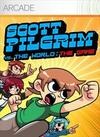Imitating the Classics... To A Fault
Like the classics of the beat 'em up genre, Scott Pilgrim focuses on one or more characters moving through a linear world and pummeling the crap out of a variety of enemies. The game typically boils down to a super linear series of fighting dudes, moving to the right, fighting more dudes, moving a little more to the right, etc. There are four playable characters and tons of items littered about the environments to add much needed variety to the experience, however, so as repetitive as that structure may sound, it never becomes too much of a problem as long as you play the game in small enough doses.
Setting a Scott Pilgrim game as a beat 'em up is all well and good, but it feels like the classic conventions of the genre are limiting the game at times. Character movement, for example, feels super stiff despite some awesome animations. This game suffers from the same problem as a great many brawlers: it can be really difficult to properly line up your characters. This results in situations where you will try to punch an enemy but the hit won't land because you're ever so slightly too high or too low. So you'll move up or down in an attempt to readjust yourself, and the enemy will often move at the same time, meaning that you have to realign yourself again. It would have been so much easier if the game had just given players three planes to move between, like in Littlebigplanet, instead of forcing them to fumble clumsily around trying to land a hit.
Once the fists do start flying, the game is solid but not perfect. Basic attacks are performed with the square button, with strong attacks being set to triangle, block to circle, and jump to X. In addition to these maneuvers, each character has their own unique special moves set to the R1 and L1 buttons that drain from a pool of mana-esque power underneath the health bar, so you can't spam your specials. Other than lining up the hits, the combat feels great. For anyone who has enjoyed classic brawlers such as Double Dragon or the TMNT arcade games, Scott Pilgrim will bring waves of wonderful nostalgia crashing over you when those hits connect.
Unfortunately, Ubisoft chose to ignore the fact that modern controllers have more than six buttons, and they gave the square button multiple functions. As mentioned earlier, there are tons of items scattered about the environments that can be used to put the hurt on enemies. In addition to the basic attack, the square button will make your character pick up an item from the ground. I can't tell you how many times I meant to attack an enemy and instead ended up squatting over to pick up a snowball or an umbrella, getting a knuckle sandwich to the face in the process. The integration of items into the game is fun and adds some variety to the combat, but I wish that Ubisoft had set the function to the R2 or L2 buttons instead, because in a game as difficult as this, it's important to be as precise as possible with the controls.
With the janky movement and some odd control decisions coupled with a high difficulty, this game may not be for you if you intend to fly solo. Luckily, Scott Pilgrim's entertainment value increases exponentially with each friend added to the mix, with up to four players possible on one television. What was in the single player game a fairly controlled experience will become barely controlled chaos with four players on the screen at once. Sadly, the game only supports split screen play with no online play whatsoever. It really would have been nice to have the option to go online with this game for those of us who don't have friends who are interested in the genre.
Although Scott Pilgrim's gameplay is ultimately dated, the visuals and audio are anything but. Or rather, they charmingly approximate those now-dated brawlers we remember so fondly using modern technology to create a look and sound that is majorly charming. Simply put, this game is gorgeous. The character animations are wonderful and the colors pop out of the screen. Just looking at screen shots won't do this game justice; it has to be seen in motion to be truly appreciated. Similarly, the music is a glorious tribute to the classic 8 and 16 bit tunes from games of old, and it fits the mood that the game is trying to create perfectly.
No matter how charming the old school presentation is, however, it can't overshadow the fact that this classic gameplay could use an upgrade. While the actual fighting feels quite solid, the game stumbles when it comes to movement and item management. It feels like the game is imitating its inspirations to a fault, taking the bad with the good. It's a shame, because Scott Pilgrim could have revitalized the sidescrolling beat 'em up genre. Instead, it will appeal to a group of nostalgic enthusiasts more than most mainstream gamers.

